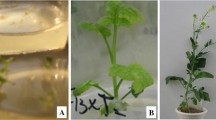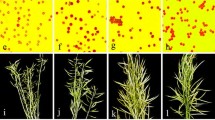Abstract
Brassica napus, an allopolyploid species having the A genome of B. rapa and the C genome of B. oleracea, is self-compatible, although both B. rapa and B. oleracea are self-incompatible. We have previously reported that SP11/SCR alleles are not expressed in anthers, while SRK alleles are functional in the stigma in B. napus cv. ‘Westar’, which has BnS-1 similar to B. rapa S-47 and BnS-6 similar to B. oleracea S-15. This genotype is the most frequent S genotype in B. napus, and we hypothesized that the loss of the function of SP11 is the primary cause of the self-compatibility of ‘Westar’. To verify this hypothesis, we transformed ‘Westar’ plants with the SP11 allele of B. rapa S-47. All the transgenic plants and their progeny were completely self-incompatible, demonstrating self-compatibility to be due to the S haplotype having the non-functional SP11 allele in the A genome, which suppresses a functional recessive SP11 allele in the C genome. An artificially synthesized B. napus line having two recessive SP11 alleles was developed by interspecific hybridization between B. rapa and B. oleracea. This line was self-incompatible, but F1 hybrids between this line and ‘Westar’ were self-compatible. These results suggest that the self-compatibility mechanism of ‘Westar’ is applicable to F1 seed production in B. napus.





Similar content being viewed by others
References
Bateman AJ (1955) Self-incompatibility systems in angiosperms. III. Cruciferae. Heredity 9:52–68
Cabrillac D, Cock JM, Dumas C, Gaude T (2001) The S-locus receptor kinase is inhibited by thioredoxins and activated by pollen coat proteins. Nature 410:220–223
Fujimoto R, Sugimura T, Fukai E, Nishio T (2006a) Suppression of gene expression of a recessive SP11/SCR allele by an untranscribed SP11/SCR allele in Brassica self-incompatibility. Plant Mol Biol 61:577–587
Fujimoto R, Okazaki K, Fukai E, Kusaba M, Nishio T (2006b) Comparison of the genome structure of the self-incompatibility (S) locus in interspecific pairs of S haplotypes. Genetics 173:1157–1167
Gamborg OL, Miller RA, Ojima K (1968) Nutrient requirements of suspension cultures of soybean root cells. Exp Cell Res 50:151–158
Goring DR, Banks P, Beversdorf WD, Rothstein SJ (1992) Use of the polymerase chain reaction to isolate an S-locus glycoprotein cDNA introgressed from B. campestris into B. napus ssp. oleifera. Mol Gen Genet 234:185–192
Gu T, Mazzurco M, Sulaman W, Matias DD, Goring DR (1998) Binding of an arm repeat protein to the kinase domain of the S-locus receptor kinase. Proc Natl Acad Sci. USA 95:382–387
Inomata (1977) Production of interspecific hybrids between Brassica campestris and Brassica oleracea by culture in vitro of excised ovaries. I. Effects of yeast extract and casein hydrolysate on the development of excised ovaries. Jpn J Breed 27:295–304
Kachroo A, Schopfer CR, Nasrallah ME, Nasrallah JB (2001) Allele-specific receptor-ligand interactions in Brassica self-incompatibility. Science 293:1824–1826
Lowson J, Williams W (1976) The effect of genotype on levels of pseudocompatibility and the production of improved varieties in Brassica oleracea. J Hortic Sci 51:123–132
Murase K, Shiba H, Iwano M, Che FS, Watanabe M, Isogai A, Takayama S (2004) A membrane-anchored protein kinase involved in Brassica self-incompatibility signaling. Science 303:1516–1519
Murashige T, Skoog F (1962) A revised medium for rapid growth and bioassay with tobacco tissue culture. Physiol Plant 15:473–497
Murray MG, Thompson WF (1980) Rapid isolation of high molecular weight plant DNA. Nucl Acid Res 8:4321–4325
Nasrallah JB, Nishio T, Nasrallah ME (1991) The self-incompatibility genes of Brassica: expression and use in genetic ablation of floral tissues. Annu Rev Plant Physiol Plant Mol Biol 42:393–422
Nasrallah JB, Nasrallah ME (1993) Pollen-stigma signaling in the sporophytic self-incompatibility response. Plant Cell 5:1325–1335
Nasrallah JB, Liu P, Sherman-Broyles S, Schmidt R, Nasrallah ME (2007) Epigenetic mechanisms for breakdown of self-incompatibility in interspecific hybrids. Genetics 175:1965–1973
Okamoto S, Odashima M, Fujimoto R, Sato Y, Kitashiba H, Nishio T (2007) Self-compatibility in Brassica napus is caused by independent mutations in S-locus genes. Plant J 50:391–400
Sato Y, Sato K, Nishio T (2006) Interspecific pairs of class-II S haplotypes having different recognition specificity between Brassica oleracea and Brassica rapa. Plant Cell Physiol 47:340–345
Schopfer CR, Nasrallah ME, Nasrallah JB (1999) The male determinant of self-incompatibility in Brassica. Science 286:1697–1700
Stein JC, Howlett B, Boys DC, Nasrallah ME, Nasrallah JB (1991) Molecular cloning of a putative receptor protein kinase gene encoded at self-incompatibility locus of Brassica oleracea. Proc Natl Acad Sci USA 88:8816–8820
Suzuki G, Kai N, Hirose T, Fukui K, Nishio T, Takayama S, Isogai A, Watanabe M, Hinata K (1999) Genomic organization of the S locus: Identification and characterization of genes in SLG/SRK region of S 9 haplotype of Brassica campestris (syn. rapa). Genetics 153:391–400
Takasaki T, Hatakeyama K, Ojima K, Watanabe M, Toriyama K, Hinata K (1997) Factors influencing Agrobacterium-mediated transformation of Brassica rapa L. Breed. Science 47:127–134
Takayama S, Shimosato H, Shiba H, Funato M, Che FS, Watanabe M, Iwano M, Isogai A (2001) Direct ligand-receptor complex interaction controls Brassica self-incompatibility. Nature 413:535–538
Takuno S, Fujimoto R, Sugimura T, Sato K, Okamoto S, Zhang S-L, Nishio T (2007) Effects of recombination on the hitchhiking diversity in Brassica self-incompatibility locus complex. Genetics 177:949–958
Tarutani Y, Shiba H, Iwano M, Kakizaki T, Suzuki G, Watanabe M, Isogai A, Takayama S (2010) Trans-acting small RNA determines dominance relationships in Brassica self-incompatibility. Nature 466:983–986
Zhang XG, Ma CZ, Tang JY, Tang W, Tu JX, Shen JX, Fu TD (2008) Distribution of S haplotypes and its relationship with restorer-maintainers of self-incompatibility in cultivated Brassica napus. Theor Appl Genet 117:171–179
Acknowledgments
This work was supported in part by the Program for Promotion of Basic and Applied Researches for Innovations in Bio-oriented Industry (BRAIN).
Author information
Authors and Affiliations
Corresponding author
Additional information
Communicated by C. Quiros.
Electronic supplementary material
Below is the link to the electronic supplementary material.
122_2011_1600_MOESM1_ESM.pdf
Supplementary Fig. 1. Genomic Southern-blot analysis of transgenic plants using a probe of BrSP11-47. Genomic DNAs of transgenic plants (1: TSP11-47-1, 2: TSP11-47-2, 3: TSP11-47-3) were digested with HindIII (left) or SacI (right). Bands different from those of ‘Westar’ are of transgenes (PDF 47 kb)
122_2011_1600_MOESM2_ESM.pdf
Supplementary Fig. 2. GUS activity in pollen grains of a transgenic plant with the BrSP11-47 promoter::GUS transgene. Pollen grains of 4, 5, and 10-mm-long buds were stained by X-gluc (PDF 161 kb)
122_2011_1600_MOESM5_ESM.pdf
Supplementary Fig. 5. Amounts of transcripts of BrSP11-47 analyzed by real-time RT-PCR in T1 plants. Relative values are shown with a standard of BrS-47 (= 1). Measurements were repeated three times, and bars indicate SE (PDF 46 kb)
Rights and permissions
About this article
Cite this article
Tochigi, T., Udagawa, H., Li, F. et al. The self-compatibility mechanism in Brassica napus L. is applicable to F1 hybrid breeding. Theor Appl Genet 123, 475–482 (2011). https://doi.org/10.1007/s00122-011-1600-1
Received:
Accepted:
Published:
Issue Date:
DOI: https://doi.org/10.1007/s00122-011-1600-1




